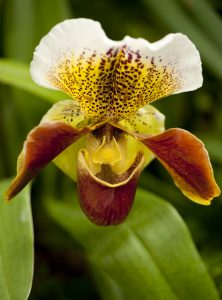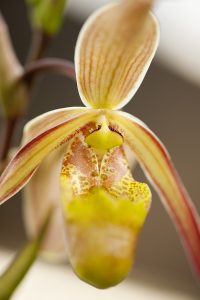What’s in a Name? Paphs, Cyps, and Phrags
Posted in History on March 9 2017, by Katherine Wagner-Reiss
Katherine Wagner-Reiss has a Certificate in Botany from The New York Botanical Garden and has been a tour guide at NYBG for the past two years.
 The Orchid Show: Thailand features a genus of lady’s slipper orchids native to Eastern Asia known as Paphiopedilum. The Latin name has a beautiful background story relating to the birth of Aphrodite, goddess of love, beauty, and fertility.
The Orchid Show: Thailand features a genus of lady’s slipper orchids native to Eastern Asia known as Paphiopedilum. The Latin name has a beautiful background story relating to the birth of Aphrodite, goddess of love, beauty, and fertility.
According to ancient Greek myth, Aphrodite was born out of the sea, and landed at the site of Paphos on the island of Cyprus. A great temple was built in her honor at Paphos (and ruins remain there today). This orchid’s shape and beauty would have made it a suitable slipper for the goddess of love; hence it was named Paphiopedilum (Paphio- for the city of Paphos, –pedilum from the Ancient Greek word pedilon, meaning slipper).
Cypripedium is a genus of lady’s slipper orchid native to most of the Northern Hemisphere, and it also happens to have a name inspired by the popular Aphrodite (Cypri– because Aphrodite was the Lady of Cyprus). Another common genus of lady’s slipper orchid, native to Mexico and South America, has a much more scientifically derived Latin name: Phragmipedium (Phragma is Greek for “division,” i.e. the ovary is divided into three).
 You may also hear these flowers referred to as Venus’ slippers, as Venus is the Roman counterpart to the Greek goddess Aphrodite.
You may also hear these flowers referred to as Venus’ slippers, as Venus is the Roman counterpart to the Greek goddess Aphrodite.
Beautiful as these names are, they can trip the tongue, and so they are abbreviated in the orchid trade as Paphs, Cyps, and Phrags.
One of my personal favorite moments is to see the various species of Cypripedium emerging in the spring, after a cold New York winter, displaying their ephemeral, Aphrodite-like beauty in the Native Plant Garden. But you can find lady’s slipper orchids from each genus blooming indoors at NYBG year-round—and, of course, throughout the Orchid Show, running through April 9.


SUPERB in every way!
Great Photos and Very Interesting Text!
Hope you write more; I love linking mythology to our flowers.